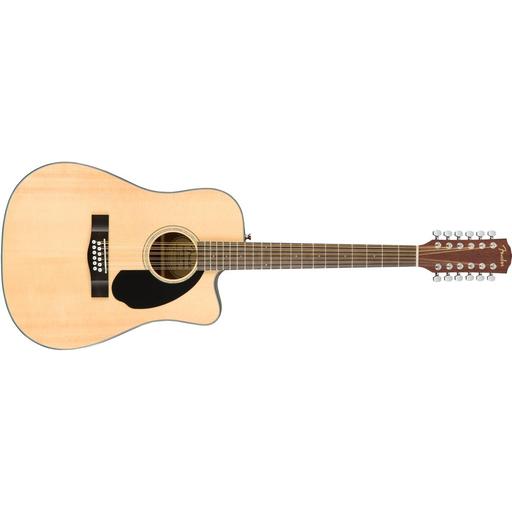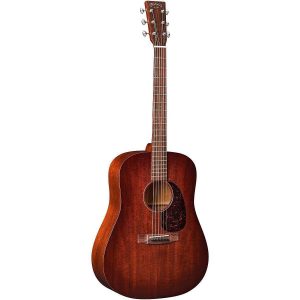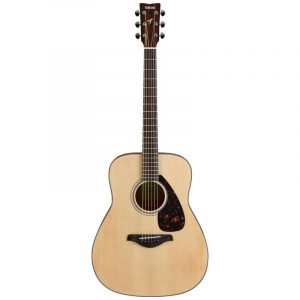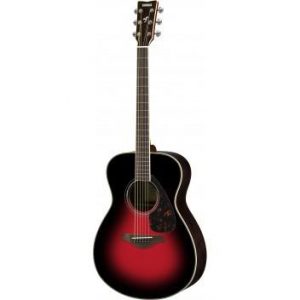Fender CD-60SCE Dreadnought 12-String
$207.99
The Fender CD-60SCE Dreadnought 12-String is the perfect combination of style and sound, offering superb tonal and projection quality for any guitarist.
Compare
Description
Fender CD-60SCE Dreadnought 12-String acoustic guitar is a versatile and affordable instrument that delivers great sound and playability. This guitar is perfect for the beginner or intermediate player who wants to explore the world of 12-string guitars.
The Fender CD-60SCE Dreadnought 12-String acoustic guitar is constructed with a solid spruce top, laminated mahogany back and sides, and a mahogany neck with a rosewood fingerboard. This combination of woods creates a warm, full-bodied sound with excellent projection.
The guitar features Fender’s Fishman Isys III pickup system, which delivers great amplified sound. The system includes a built-in tuner and volume and tone controls located on the top edge of the guitar for easy access.
The CD-60SCE Dreadnought 12-String’s bridge is also made of rosewood with a compensated saddle for improved intonation. The guitar’s headstock is equipped with chrome die-cast tuners that are easy to turn, ensuring accurate tuning.
This guitar is perfect for playing a wide range of musical styles, from folk to blues to rock. Whether you’re strumming chords or fingerpicking intricate arrangements, the Fender CD-60SCE Dreadnought 12-String acoustic guitar is up to the task.
In terms of design, the guitar is sleek, with a glossy finish and a natural wood pattern visible through the gloss. The dreadnought body shape also looks great on stage or in the studio.
In conclusion, the Fender CD-60SCE Dreadnought 12-String acoustic guitar is a great instrument for players of all levels. Its solid construction, great sound, and versatile playability make it an excellent choice for anyone looking to invest in a quality 12-string guitar.
Fender CD-60SCE Dreadnought 12-String properties
| Product name |
Fender CD-60SCE Dreadnought 12-String |
| Brand |
Fender |
| Type |
Acoustic Guitars |
| Number of Strings |
12 pcs |
| String Type |
Steel |
| Built-In Microphone |
Yes |
| Handedness |
Right-Handed |
| Number of Frets |
20 |
| Cutaway |
Single Cutaway |
| Size |
Dreadnought |
| Pick Guard |
Yes |
| Wood Type (front) |
Spruce |
| Wood Type (back) |
Mahogany |
| Wood Type (body sides) |
Mahogany |
| Wood Type (neck) |
Mahogany |
| Wood Type (fretboard) |
Walnut |
| Colour |
Wood |
Frequently Asked Questions:
What are some tips for beginners to get started with playing my Fender CD-60SCE Dreadnought 12-String Acoustic Guitar?
1. Start by learning basic chords: Beginners should start by learning the most common chords like A, D, E, G, C, and F. These are the basic building blocks for playing songs on the guitar.
2. Practice strumming techniques: Once you've learned a few chords, practice strumming them one at a time and then combine them to play simple songs or progressions. Start slow and gradually increase your speed as you become more comfortable with the chord changes.
3. Develop finger dexterity: One of the challenges of playing a 12-string guitar is that it requires greater finger strength and dexterity than a regular six-string guitar. To build up these skills, practice exercises like scales and arpeggios to strengthen your fingers and improve your coordination.
4. Use a capo: A capo is an essential tool for 12-string guitarists as it allows you to play in different keys without having to constantly change the chord shapes. Learn how to use a capo properly and experiment with placing it on different frets to explore new sounds and chord progressions.
5. Play along with your favorite songs: Choose some of your favorite songs that are within your current skill level and play along with them using the chords and strumming patterns you've learned so far. This will help you develop your ear for music and improve your overall musicianship.
6. Experiment with different tunings: The standard tuning for a 12-string guitar is the same as a regular six-string guitar, but there are also various alternative tunings that can create unique sounds and textures. Try experimenting with different tunings to find one that suits your style and preferences.
7. Join a local music community: Connecting with other musicians is an excellent way to grow as a player. Look for local jam sessions, open mics, or guitar groups where you can meet like-minded individuals who share your passion for playing the guitar.
8. Take lessons: If you're serious about learning how to play the 12-string guitar, consider taking lessons from a qualified instructor. They can provide personalized guidance and feedback to help you improve your technique and reach your goals faster.
9. Practice regularly: Like any skill, playing the guitar requires consistent practice to get better. Set aside dedicated time each day or week to work on specific techniques, learn new songs, or explore different styles of music.
10. Have fun: Above all else, remember that playing the guitar should be enjoyable! Don't get too caught up in perfecting every detail or comparing yourself to other musicians. Embrace your unique style and enjoy the process of learning and growing as a player.
What are some recommended maintenance and care tips for the Fender CD-60SCe Dreadnought 12-string acoustic guitar?
The Fender CD-60SCe Dreadnought 12-string acoustic guitar is a beautiful instrument that requires proper maintenance and care to keep it sounding great and looking good for years to come. Here are some recommended tips:
1. **Regular Cleaning:** Wipe down the body, neck, and fretboard of your guitar with a soft, dry cloth after each use. This will remove dust, sweat, and other contaminants that can damage your instrument over time.
2. **String Maintenance:** Change your strings regularly – at least every 3-4 months or more frequently if you play often. Dirty or worn-out strings can affect the tone of your guitar and make it harder to play. Always use high-quality strings designed specifically for a 12-string guitar.
3. **Humidity Control:** The wood in your guitar is sensitive to changes in humidity. Store your instrument in a room with stable humidity levels between 45% - 55%. If you live in an area with extreme weather conditions, consider using a humidifier or dehumidifier to maintain the right environment for your guitar.
4. **Tuning and Set Up:** Have a professional technician check your guitar's tuning and set up periodically. This includes adjusting the truss rod, nut, and saddle height to ensure proper intonation and playability.
5. **Protective Case:** Always store your guitar in a protective case when not in use. This helps protect it from accidental bumps, scratches, and other damage. Choose a case that fits snugly around your instrument without putting too much pressure on the body or neck.
6. **Polishing:** Occasionally polish your guitar's finish with a gentle cleaner specifically designed for guitars. This helps restore shine and protect against wear and tear. Avoid using harsh chemicals, abrasive materials, or excessive heat that could damage the wood or finish.
7. **Playing Technique:** Use proper playing technique to avoid putting unnecessary stress on your guitar. For example, always hold the neck at the body joint rather than close to the bridge or headstock. This helps prevent warping and other structural issues.
By following these maintenance tips, you can help ensure that your Fender CD-60SCe Dreadnought 12-string acoustic guitar stays in great condition for many years of enjoyable playing.
How does the onboard tuner feature of the Fender CD-60SCE Dreadnought 12-String differ from traditional tuning methods, and what benefits does it offer for acoustic guitar players?
The Fender CD-60SCE Dreadnought 12-String guitar is equipped with a convenient onboard tuner feature that sets it apart from traditional tuning methods. Unlike manual tuning techniques, which require the use of an external tuner or ear training, this built-in tuner allows for quick and easy tuning right from the guitar itself. This feature is particularly beneficial for acoustic guitar players who often perform in situations where access to an external tuner may not be practical or convenient. With the Fender CD-60SCE Dreadnought 12-String's onboard tuner, musicians can quickly and accurately tune their instrument without having to stop playing mid-performance or interrupt the flow of their practice session. This feature adds a level of convenience and versatility that makes the Fender CD-60SCE Dreadnought 12-String an excellent choice for acoustic guitar players of all skill levels.
What specific adjustments can be made to the bridge and action on a newly purchased Fender CD-60SCE Dreadnought 12-String Acoustic Guitar to optimize its playability and tone?
**Adjustments to the Bridge:**
1. Bridge Height**: The bridge on the CD-60SCE can be adjusted to suit your playing style. If you're experiencing buzzing or rattling on the high E string (thinnest string), try lowering the bridge by loosening the screws and then tightening them in small increments while checking for clearance. Action at the Bridge**: Check the action (string height) at the bridge, particularly for the low E and A strings. If it's too high, you may want to adjust the bridge or consider replacing the bridge pins with ones that are specifically designed for a 12-string guitar. Adjustments on the Action:**
1. Nut Height**: The nut on the CD-60SCE can be adjusted using the nut slots' built-in height adjustment feature. If the action is too high at the nut, you can lower it by adjusting the nut slots. This will help reduce buzzing and rattling. Action at the Nut**: Check the action (string height) at the nut, particularly for the low E string. If it's too high, you may want to adjust the nut or consider replacing the nut with one that's specifically designed for a 12-string guitar. Additional Adjustments:**
1. Fretboard Radius**: The CD-60SCE has a flat fretboard radius (13. If you're used to playing guitars with a more curved radius, you may find it difficult to press the strings down at the frets. Consider using a fretboard radius compensation tool or taking your guitar to a professional setup. String Set**: The CD-60SCE comes with a set of medium gauge strings (0. If you prefer a lower action, consider replacing the strings with a lighter gauge set (e. Tone Optimization:**
1. String Selection**: Experiment with different string sets to find one that suits your playing style and tone preferences. Bridge Pins**: Consider replacing the bridge pins with ones that are specifically designed for a 12-string guitar. This can help improve the guitar's sustain and tone. Pickup Settings (if equipped)**: If your CD-60SCE has a built-in pickup system, experiment with different settings to find one that complements your playing style. Professional Setup Recommendation**
If you're not comfortable making these adjustments yourself or if you're unsure about any of the above steps, I highly recommend taking your guitar to a professional setup. A reputable luthier can assess your guitar and make the necessary adjustments to optimize its playability and tone. Remember, adjusting the bridge and action on your guitar is a process that requires patience and attention to detail. Make sure to check the guitar's playability and tone after each adjustment before making further changes.
What is the optimal setup for the bridge pins on a Fender CD-60SCE Dreadnought 12-String guitar to prevent string slippage and maintain proper tuning?
1. For each string set, place the high E string at the top and the low E string at the bottom. Position a pin on either side of the low E string, making sure they're equidistant from the bridge plate. This will ensure that the strings are seated properly in the bridge. The correct alignment is crucial here: you want to make sure that each pair of strings is separated by a pin, and that those pins are positioned evenly. For each set of 4 strings (high E, B, G, D), place a pin on either side of the high E string. This will keep the strings from slipping out of the bridge. Now, let's talk about how to secure the pins:
To prevent string slippage and maintain proper tuning, you'll want to make sure that each pin is seated properly in its corresponding hole. Here are a few tips for securing those pins:
* Use a pin punch or a small screwdriver to tap each pin into place. Make sure they're seated about 1/8 inch deep. Once the pins are seated, use the bridge pin clamp screws to tighten them down evenly. You want to make sure that each string set is securely fastened. It's also worth noting that you may need to adjust the bridge pin height depending on how your guitar is set up. If your strings are too long, it can cause tuning issues and put unnecessary stress on the neck. To adjust the bridge pin height:
* Loosen the bridge pin clamp screws. Use a pin punch or small screwdriver to gently pry each pin out of its hole. Once all the pins are removed, you can adjust their height by turning them clockwise or counterclockwise. This will raise or lower the string action. In any case, it's always best to consult your guitar's manual for specific instructions on how to set up and maintain your instrument.
Before you buy Fender CD-60SCE Dreadnought 12-String










Reviews
There are no reviews yet.